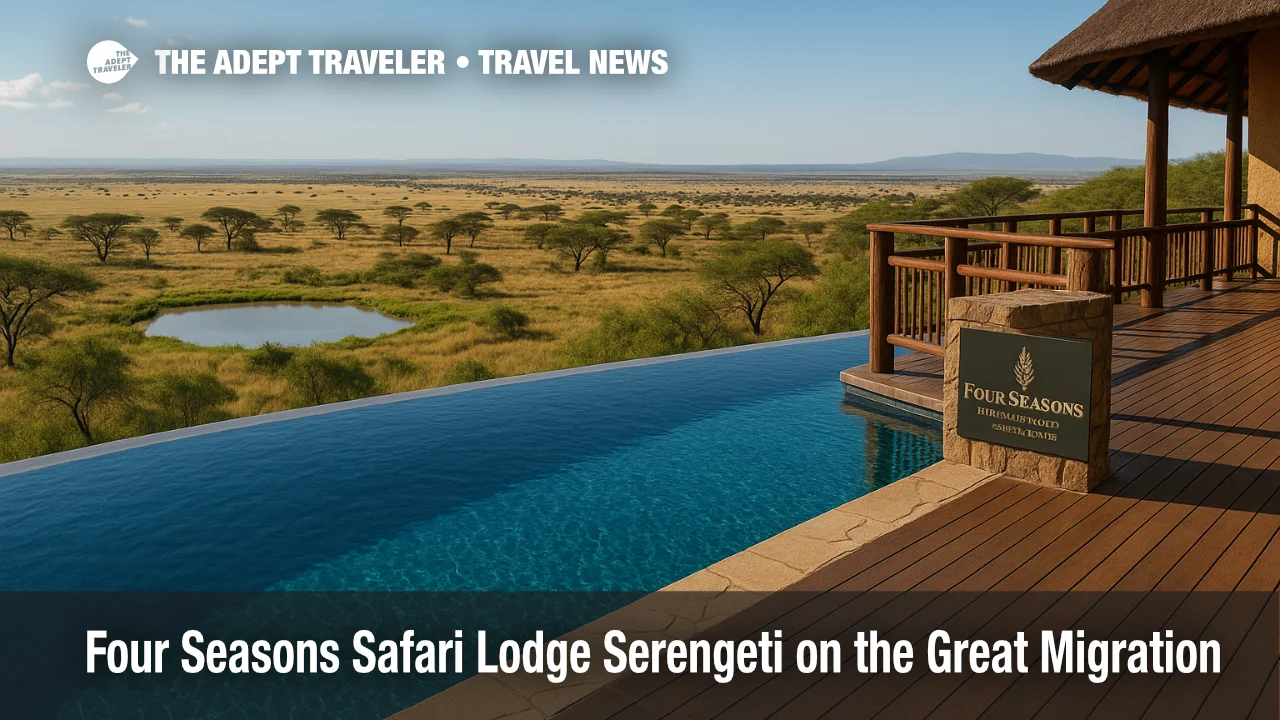Four Seasons Safari Lodge Serengeti on the Great Migration

In Tanzania's Serengeti National Park, the Great Migration unfolds in an ancient rhythm that still governs life on the plains. Four Seasons Safari Lodge Serengeti sits in the Central Serengeti, positioning travelers to see moving herds in multiple seasons without changing camps. From game-drive access to the Western Corridor and Ndutu, to year-round wildlife at the lodge's watering hole, the property refines migration viewing from a single, luxurious base.
Key Points
- Why it matters: Year-round access from a central base reduces repositioning and crowding.
- Travel impact: Balloon, walking, and guided drives time sightings to migration hot spots.
- What's next: Late December through early April favors Ndutu calving, May to early July favors the Western Corridor.
- Expert naturalists coordinate full-day drives to Grumeti and seasonal plains.
- Infinity pool and watering hole deliver wildlife viewing between drives.
Snapshot
Two million grazing animals cross the Serengeti-Mara ecosystem each year, a spectacle concentrated by season but continuous in motion. The lodge's elevated walkways overlook an active watering hole, while full- and half-day drives fan out to Seronera, Ndutu, and the Western Corridor based on rainfall and grass. Walking safaris near the lodge focus on tracks, birds, and smaller wonders that vehicles miss. Hot air balloon safaris reveal herd patterns at sunrise. For logistics, most visitors connect via Kilimanjaro International Airport (JRO) to Arusha Airport (ARK), then fly about one hour to Seronera Airstrip (SEU), with round-trip lodge transfers from SEU included in many packages. See our primer on gateways in Arusha, Tanzania.
Background
The Serengeti is both a wildlife refuge and a working landscape shaped by rain, grass growth, and age-old routes. Calving concentrates in the southern plains around February and March, when hundreds of thousands of wildebeest are born and predators follow the pulse of new life. As grazing wanes, herds stream northwest toward the Western Corridor in late May and June, then continue toward the north. A Central Serengeti base offers flexible range to these key zones, with guides adjusting daily plans around weather and movement reports. The lodge also emphasizes education at its Discovery Centre and designs experiences, such as guided walks, to keep vehicle density lower in sensitive moments. For crowding basics, see Africa.
Latest Developments
Why Four Seasons Safari Lodge Serengeti anchors the Great Migration
Four Seasons' central location allows the team to chase edges of the migration without constant hotel changes. In late December through early April, guides target the Southern Serengeti and Ndutu, where births and short-grass grazing dominate. From late May to early July, attention shifts to the Western Corridor, where the rut occurs and the herds face Grumeti River crocodiles. The remainder of the year, rich Seronera habitat and nearby Togoro Plains support big cats and resident game, maintaining strong wildlife density even when the main herds push north. On site, travelers can add walking safaris with Maasai guides and park rangers, hot air balloon flights at sunrise, and photographic tutorials that elevate technique while respecting distance and animal behavior. Between drives, the infinity pool overlooks a busy watering hole that keeps the viewing going.
Analysis
A single-base migration strategy trades the frantic chase for smart positioning and timing. Central Serengeti access gives drivers multiple seasonal options, preserving comfort, and reducing the common mistake of leapfrogging herds. The lodge's walking safaris add value by slowing down, which surfaces smaller behaviors, fresh tracks, and birdlife that big-ticket sightings can overshadow. Balloon flights contribute a pattern-level view, clarifying how herds, predators, and waterways interact across the plains. Education through the Discovery Centre aligns with responsible-travel goals, helping guests understand why clustering too closely at river crossings stresses wildlife. Operationally, a one-hour hop from Arusha to Seronera simplifies arrivals, and the property's transfers reduce ground-logistics friction. Seasonality remains the key variable, so travelers should book for clear objectives, for example, calving in February, Grumeti in June, or broad resident-game diversity the rest of the year. This approach balances spectacle, comfort, and ethics, which fits today's demand for high-end safaris that minimize impact while maximizing learning.
Final Thoughts
If your goal is to witness the Great Migration without packing and unpacking across multiple camps, a central base makes sense. Four Seasons Safari Lodge Serengeti pairs expert guiding with low-impact alternatives such as walking and balloon safaris, then adds meaningful interpretation at the Discovery Centre. Time your trip around birthing in the south, the Western Corridor rut and river drama, or resident-game density near Seronera, and you will still return to the same room and the same watering hole view. For many travelers, that is the most elegant way to experience the Great Migration at Four Seasons Safari Lodge Serengeti.
Sources
- Four Seasons Safari Lodge Serengeti, official site
- Seasons of the Serengeti, Four Seasons
- The Western Corridor, Four Seasons
- Southern Serengeti and Ndutu, Four Seasons
- Walking Safari, Four Seasons
- Serengeti Balloon Safari, Four Seasons
- Photos, watering hole and pool, Four Seasons
- Serengeti National Park listing, UNESCO
- Great Migration overview, Altezza Travel
- Flight time JRO or ARK to SEU, FlightConnections
